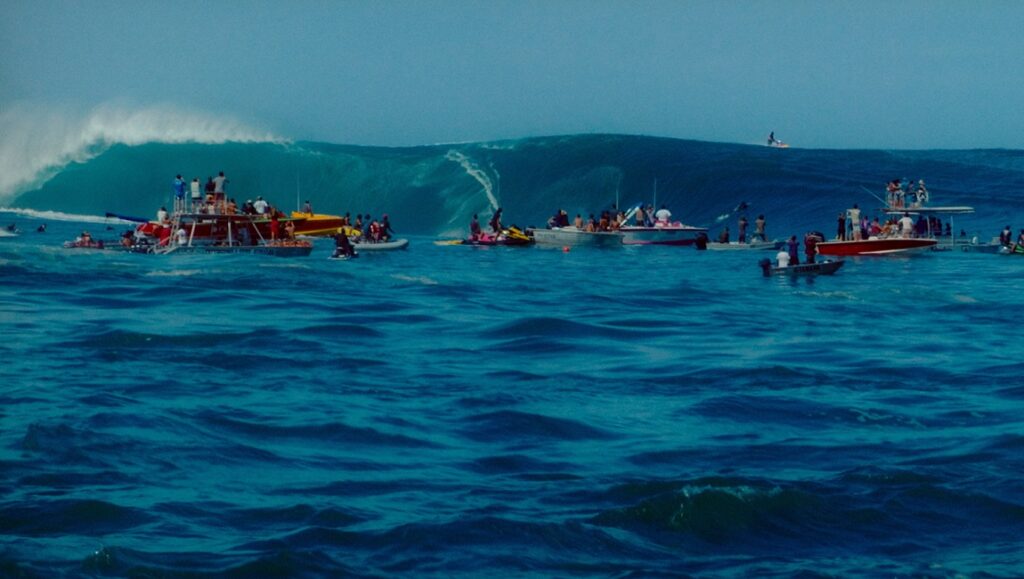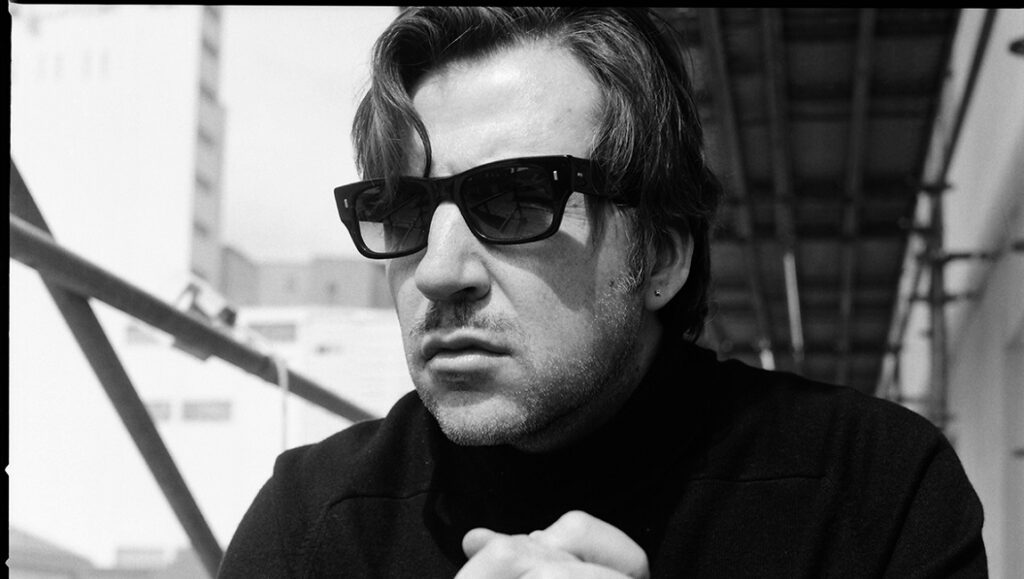Despite boasting a filmography mostly known for its unorthodox approximations to period detail and the formal subversions that come with it, the defining characteristic of Albert Serra’s fiction oeuvre might be its subtler thematic undercurrents around the anxiety of insignificance. Since the bumbling buffoons of Don Quixote and Sancho Panza struggling to cope with the death of chivalry in Honour of the Knights (2006), Serra’s feature-length works have traversed different approximations to the innate tension of seeing all of one’s values and convictions crumble in real time, finding a particular fascination in the sordid details that arise within these decaying environments.
Pacifiction sees Serra return to many of these recurring concerns, but from a refreshed perspective, one less interested in conceptual extravagance and provocation than in playing with the medium’s possibilities and taking them to their utmost limits. In this conversation, the Catalan filmmaker talks through his stylistic evolution, the challenge of fabricating icons for a contemporary setting, and the possibilities that come with sonic exploration.
Since the release of Liberté in 2019, you’ve talked about growing tired of historic depictions, and wanting to establish some kind of dialogue with the contemporary world. Did any creative challenges arise while making this contextual switch in Pacifiction?
For me, the change wasn’t just about wanting to explore something for my own artistic reasons, more so than it’s also an inherent part of the world. In my historic works, I now feel there’s a sense of artificiality; these worlds feel a bit staged to me. Just by working with performers, the fact that you’re doing an historic fiction gives them some sense of grounding in certain iconographies. You don’t really have to create anything. With the contemporary, you have to create something with no timely referents; you’re constructing in real time, basically.
Also, a film as conceptual as Liberté really doesn’t work in a contemporary context — it needs the safety net and background of historicity to avoid being pure abstraction. So I really wanted to engage with a more narrative approach, to really go into a sense of adventure that allows for other kinds of observations. I took a lot from Stendhal, actually. It wasn’t a thing about having a thesis on colonialism, nuclear war, or corruption. I feel that without a political agenda, the film could exist more freely. That’s why it essentially combines a more objective mise-en-scène, with a very subjective point of view. It helps make everything more diffuse and enhance the feel of disorientation.
In your previous works, you did play a lot with the value of icons, essentially subverting their canonical depictions — Casanova and Dracula in Història de la meva mort, Don Quixote in Honor de Cavallería, the Three Wise Kings in El cant dels ocells. What was the process of creating De Roller as your contemporary icon?
A lot came from working with the actors. Benoît Magimel already boasts a pretty iconic face, with lots of ambiguity and a sense of ruggedness to it. Then ideas came during the shooting. Things as essential as De Roller’s tacky sunglasses were pretty much Magimel’s initiative, and they perfectly embody what I wanted for the character. You really can’t read his reactions or what he’s thinking about. I also told Benoît to wear the white suit at all times, so it became like a second skin to him.
In a way, since I don’t really read the script with my actors or anything, De Roller came to be an almost hyperrealistic performance from Magimel, building the character in real time while he was on screen. Every decision seemed to double-down on his grotesque aura, like, for example, showing his tattoo. As soon as you see that, you ask yourself what kind of people you’re actually dealing with.

In the film, De Roller does feel like the anchor that holds together a collapsing vessel, which is the world around him. Despite not having the inherent meaning projected into your previous narrative works due to their historic setting, Pacifiction also feels like those last moments before inevitable change. What’s your relationship with this apocalyptic idea around “the end of times”?
I love it, since the end of a period always means the death of something, and the rise of another. It’s inherently cinematographic, as there’s a natural tension palpable in the environment. You’re right, all my films can be described as some sort of portrait of an agonizing and decaying world that’s about to end. The out-of-place Libertines, Louis XIV’s death: For them, a world was ending, and then a new one immediately began.
Jean Douchet, a famous French critic, once said my films aren’t about the drama of actions, but the drama of presence. When I played with these iconic figures you mentioned earlier, the mere fact that they’re depicted on screen creates some sort of tension, and a natural narrative immediately arises. Those twilight moments in history are also very textured and rich, and I enjoy creating these baroque depictions where you can see them decomposing in every corner. In Pacifiction, the colonial setting helps amplify these tensions. It erases the nuances of a place like Europe, where we have bourgeois middle classes and all kinds of distinctions; while there, you can’t escape the duality of colonizers and the indigenous population.
Americans tend to like the optimism behind new worlds and their discovery, while we Europeans seem fixated on what’s disappearing around us, and have a weird fascination with what came before us. We’re perpetually living the end of something, I feel.
You’ve also mentioned previously the influence of ‘70s American filmmaking, which stands perhaps in a middle ground from these two sides you mention; having a sordid feel for beauty underneath their bleak and doom-laden surfaces. Do you feel that’s also the case with Pacifiction?
Yes, it’s a weirdly hopeful film for me. It has important flashes of hope, with the abstracted romance between Shona and De Roller, for example. If the film didn’t have that, perhaps it’d be too asphyxiating and conceptual, and I had already done Liberté for that.
Humor is also an important aspect of this. I like how it disorientates the viewer and puts the images on screen into question. The viewers have to ask themselves what kind of film they’re actually watching, with all the ugly sides of a colonial setting, and also the moments of absurdity that come from this world’s contradictions and constant chaos. It’s a very unstable film, which is something I feel sets it apart.

Your way of exalting these aspects of Tahiti seems very deliberate as well, particularly its sonic atmospheres, where naturalistic and artificial textures work together to create an aura of constant paranoia. How was the process of conceiving Pacifiction’s aural universe?
From the get-go, we wanted to avoid playing with an overly folkloric soundtrack. That, to me, is very boring and cliché. We did use some Tahitian and Hawaiian recordings from the 1950s, but put them on their head by mixing them with other sounds. That’s the weird music you listen to in the nightclub, for example. We wanted to keep destroying those sounds, and that’s where the music evolves into the dissonant soundscapes that basically drown out everything else and become very oppressive.
I got inspiration from Ennio Morricone’s work on some forgotten horror soundtracks from his days in Italy, and how Jean-Luc Godard used to approach sound as a layer detached from his films’ visuals. For me, it’s an obsession. I want sound to have a relationship with images, but also be able to give you additional information, and even contradict what images tell you.
Does that also relate to an idea you’ve touched upon earlier in your career about the “aristocracy of images” being almost fully independent entities?
It’s all about images having their own sovereignty. Images need to be autonomous and self-sufficient. They don’t bow down to anyone. Sovereign images are very irritating, because they don’t respect you as a viewer. They impose themselves and then mock you. Sovereign images go beyond social or political leanings, and are much purer, almost amoral. For me, cinema is about these unjust images, the ones you almost have to make an active effort to endure.
Published as part of InRO Weekly — Volume 1, Issue 7.


Comments are closed.